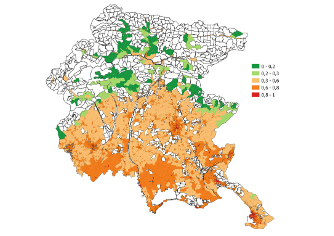- Milano
- Dipartimento di Scienze statistiche
- Ricerca
- Statistica
- The evaluation of heat vulnerability
The evaluation of heat vulnerability

Last decades have seen increasing consensus towards the issue of climate change and rising awareness of the implied responsibility of human activity. With growing global warming, extreme climate events like heat waves have increased in duration, frequency and intensity leading to higher heat-related morbidity and mortality rates. In this context, heat vulnerability assessments play an important role supporting decision-makers in implementing targeted mitigation and prevention actions. With this motivation, this research aims to develop a heat vulnerability index by means of the Composite Indicator techniques to depict heat vulnerability of different geographical areas. In particular the propsed index is used to map heat vulnerability in the Friuli Venezia Giulia region at the census tract level. The results show that heat vulnerability follows a spatial pattern, where most vulnerable census tracts are located in urbanised and densely populated areas, lower risk is observed in rural areas and lowest danger in mountainous areas. The Performance Interval approach confirms that these results do not depend on the aggregation method used to construct the index.
Parole chiave o temi trattati:
Climate change, Heat waves, Composite indicator, Heat vulnerability index
Persone coinvolte:
Dipartimento di Scienze statistiche
- Dipartimento
- Persone
- Ricerca
- Statistica
- Analisi di dati funzionali
- Analisi sequenziale
- Disegno degli esperimenti
- Modelli grafici e inferenza causale
- Serie spaziali e temporali
- Model and variable selection
- Copula e variabili di risposta categoriali
- Model-based clustering
- The evaluation of heat vulnerability
- Partial Least Squares Path Modeling
- Statistica economica
- Demografia e statistica sociale
- Informatica e intelligenza artificiale
- Ricerca applicata
- Terza Missione
- Reclutamento
- Offerta Formativa
- Seminari - Eventi
- Notizie
- Contatti
